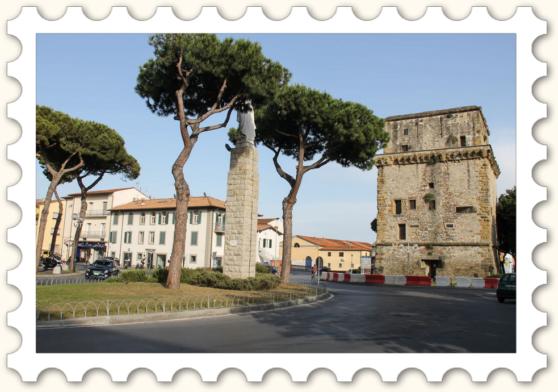 | Matilde Tower
Following the progress of the coastline, the castle of Viareggio (castrum de via regia, built in 1172 and the only access to the sea of ??Lucca from 1441 with the landing of the Selice estuary, current Burlamacca canal) was in fact about 600 m inland and was no longer effective in protecting the landing on the coast, exposed with its warehouses to attacks by Barbary pirates. The government of Lucca therefore decided to build a tower on the sea on 5 June 1534.
The Tower in the early 1900s
The construction of the new tower was made using squared stone drafts as material, which could be obtained from the partial demolition of the old castle. To finance the works, it was decided to tax, for six years, with some extraordinary gabelles, the goods that arrived in Viareggio. From his summit he greeted with blows the arrival of Emperor Charles V, who disembarked at Viareggio to meet in Lucca an emissary of Pope Paul III between 12 and 18 September 1541. The construction was completed in 1542 and in 1544 there was added a fortification wall of the village of Viareggio, built around the landing. A garrison of fifteen men was established there. In 1546-1549 there was built next to the residence of the "commissioner of the beach", in charge of the control over the village and the movement of goods. The residence was connected to the tower by a loggia.
At the beginning of the seventeenth century the tower was raised one floor and surmounted by a small bell tower with two bells.
After 1703, the public clock on the façade of the beach commissioner's house was moved to the top of the tower, whose operation was initially commissioned by an inhabitant of the place paid by the community by an annual fee of four money per family; in 1748 the task passed to the guards.
On April 15, 1780, the tower was struck by lightning, which killed a soldier on guard, but spared the next deposit of gunpowder. In thanksgiving for the escaped danger the party of the "Voto del comune" was established, suppressed in 1808 and restored in 1821.
Following the further advance of the coastline, the Selice estuary was regularized with the construction of the Burlamacca canal in 1788, next to which a new fort was built, Fortino sul Foce di Viareggio. The tower, however, retained the function of surveillance post, for the sighting of both enemies at sea and fires; the bells were also used to convoke the community parliament.
At the beginning of the nineteenth century the tower was used as a prison, in particular for inmates in transit and in 1810 a turret was installed for the telegraph. In 1813, the British landed in Viareggio and occupied Lucca to retire again on ships following the arrival of the French, without the tower garrison being able to oppose any resistance. Commander Ippolito Zibibbi was sentenced to death, with a sentence later turned into a lifetime prison, due to lack of defense. The episode highlighted the lack of effectiveness of the tower as a military garrison and remained in fact only as a prison. In 1819 Viareggio was given the title of cities and prisoners and forced, also housed in the tower, lent their work for the construction of the dock. Between 1823 and 1847 the tower was used as "forced toilets", while the actual prison was transferred to Camaiore. In 1850 it was used as a prison again and in 1854 a house for the caretaker was built next to it. The tower housed 6 cells each of which could hold up to six inmates. He maintained this function until the second world war.
Once the prison was abolished in 1945, the tower remained closed and abandoned until 1969, with the first restoration works carried out by the Superintendency for the environmental, architectural, artistic and historical heritage of Pisa. The restoration works were resumed in 1975 and were concluded in 1982, allowing to bring to light the original structure of the monument, altered by the numerous works of adaptation of the interior spaces to the different functions. The tower currently hosts cultural events and art exhibitions.
source wikipedia https://it.wikipedia.org/wiki/Torre_Matilde |
|
|

